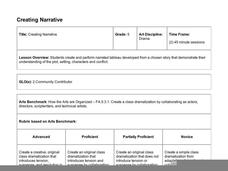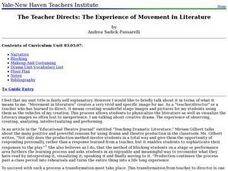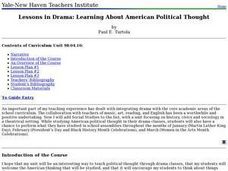Hawaiʻi State Department of Education
Creating Narrative
Plot, setting, characters, and conflict are common to both drama and narrative stories. Kids create narrated tableaus that show their understanding of the plot, setting, and conflict of a story they've recently read. The lesson...
EngageNY
Mastering Factoring
Math class is full of drama—there are so many problems to work out! Pupils work out factoring problems. They use quadratic methods of factoring higher degree polynomials, in addition to factoring the sum and difference of two...
Star Wars in the Classroom
"Shakespeare and Star Wars": Lesson Plan Day 6
How can a screenplay create meaning and drama in ways that other forms of writing cannot? That is the question class members must answer as they compare the cantina scene of the screenplay for George Lucas's Star Wars: A New Hope...
EngageNY
Grade 10 ELA Module 4, Unit 2, Lesson 26
How do directors' choices emphasize different elements of a drama? Scholars participate in a discussion about the Royal Shakespeare Company production of Macbeth and Akira Kurosawa's Throne of Blood. Finally, they write an analysis of...
EngageNY
Analyzing Language, Character, and Theme: World Café Discussion
As part of their study of A Midsummer Night's Dream, class members meet in a drama circle to discuss and role-play scenes from the play. They then engage in an activity called World Cafe, analyzing the characters' actions from the text....
EngageNY
Text to Film Comparison: Bottom’s Transformation
Scholars meet in a drama circle to discuss what they remember from reading A Midsummer Night's Dream Act III, Scene 1 in the last activity. They then take turns reading the scene aloud, stopping to answer questions as they read. Learners...
EngageNY
Author’s Craft: Poetry and Prose
During a drama circle, scholars closely examine the play created in the play A Midsummer Night's Dream. The pupils read Act 3 Scene 1 and turn and talk to their partners about the scene. They then complete a handout and discuss the...
EngageNY
Characters’ Decisions: The Flow of Consequences in Midsummer
Class members meet in their drama circles and share their thoughts on why it might be necessary for the audience to know something the characters don't. They read Act 3 Scene 2 of A Midsummer Night's Dream and complete consequence flow...
EngageNY
Text to Film Comparison: Bottom the Fool
Pretty ugly, jumbo shrimp. Oxymorons are awfully good! Scholars reread Act I, scene 2 from Shakespeare's A Midsummer Night's Dream while participating in a drama circle. Next, they begin working on anchor charts to dissect Shakespeare's...
EngageNY
Author’s Craft: The Poetry of the Play
Feel the rhythm! Pupils begin reading Act 2, Scene 1 of Shakespeare's A Midsummer Night's Dream as they continue participating in a drama circle. With discussion, they examine Shakespeare's use of rhyme, rhythm, and meter, analyzing how...
EngageNY
Analyzing Character and Theme: Tracking Control in A Midsummer Night’s Dream
Pupils first participate in a drama circle as they continue reading Shakespeare's A Midsummer Night's Dream aloud with classmates. Next, scholars move around and discuss text-dependent questions about the play with a Three Threes in a...
EngageNY
Launching A Midsummer Night’s Dream: Identifying the Characters, Settings, and Conflicts
Scholars form a drama circle and begin reading Shakespeare's A Midsummer Night's Dream. They also use a play map to identify the setting, characters, and conflicts from the text.
EngageNY
Reading Shakespeare: Understanding Shakespeare’s Language
Pupils participate in a drama circle to read Shakespeare's A Midsummer Night's Dream aloud. They work with partners to discuss Shakespeare's use of language and analyze how specific lines of dialogue within the play help propel the...
Judicial Branch of California
Protecting our Freedoms: The Bill of Rights
Take to the stage! Integrate both drama and civic skills by asking pupils to create and perform skills that demonstrate the importance of the amendments in the Bill of Rights. After reviewing the Preamble to the Constitution, learners...
Curated OER
Diversity in Media: Looking Critically at What We See
This learning experience fosters awareness of representations we see, and don't see, in the media. Learners list TV programs, games, and films they enjoy, identify characters' ethnic, religious, (dis)ability, and sexual orientation...
Curated OER
"The Party"
Students are introduced to the world of drama and explore and discuss the prospect of being an "outsider." They are encouraged to look into another person's experiences with drama. Each group of students act out short scenes to be...
Curated OER
The Russian Revolution
Students explore the Russian Revolution through dramatization. For this Russian Revolution lesson, students participate in drama workshops prior to writing and presenting one-act plays featuring figures of the revolution.
Curated OER
Semiotics and Set: Year 9
Drama enthusiasts explore the importance of set and action in conveying dramatic tension. They act out a polished dramatic piece using the set as a key component of their story. This should be connected to setting as it is also used in...
Curated OER
The Teacher Directs: The Experience of Movement in Literature
Experience movement in literature. High schoolers are introduced to new vocabulary related to drama and theatre. In groups, they use a piece of literature and develop their own skit to act out in front of the class. As a class, they...
Curated OER
I'm a Creature, You're a Creature, Wouldn't You Like to Be a Creature, Too?
Third graders demonstrate an understanding of the lifestyles and habits of the underwater life presented in the previous unit. They classify the various sea creatures according to the ecosystem and then use drama skills to present...
Curated OER
Problem Page Letter
Students discuss a dramatic situation involving realistic characters and create response "letters" to the situation in this Drama lesson for the high school classroom. The lesson emphasizes the study of empathy and sympathy as it relates...
Curated OER
Witchcraft
Tenth graders develop response to witchcraft from a historical and cultural perspective. They evaluate the use of ceremonies and rituals in witchcraft. They develop a character and develop use of genres and styles of drama. They role...
Curated OER
Lessons in Drama: Learning About American Political Thought
Students develop critical thinking skills so that they may produce their own written plays or music from their thoughts and feelings. They express their thoughts based on what has been presented to them over the duration of the course.
Curated OER
Telling Stories Through Creative Drama
Young scholars examine fairy tales. As an introductory activity, students play the statue game. In groups, they write statements that tell the plot of the story. Using props, and without voices, young scholars retell the story by...
Other popular searches
- Elements of Drama
- Dramatic Play
- Drama Games for Kids
- Drama Lesson Plans
- Drama Games
- Preschool Dramatic Play
- Creative Drama
- Drama Acting Exercises
- Drama Lessons
- Greek Drama
- Dramatic Monologue
- Fairy Tales Drama

























